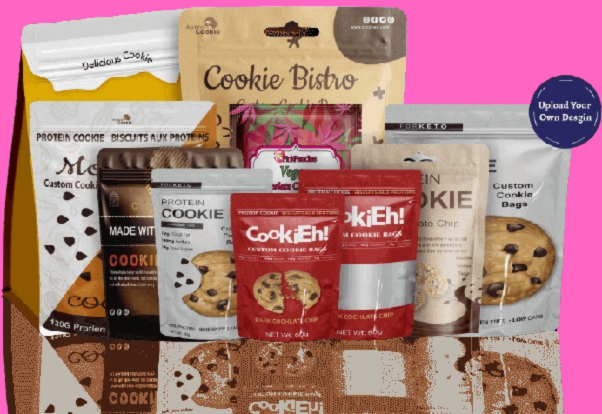Cookies are a universally loved treat, cherished by people of all ages across the globe. Whether homemade or store-bought, cookies offer a delightful experience with each bite. But beyond the cookie itself, there lies an essential component that often goes unnoticed: the cookie bag. This humble packaging plays a critical role in maintaining the freshness, flavor, and presentation of cookies. In this comprehensive article, we will delve into the various aspects of Cookie Bags, exploring their types, materials, uses, benefits, and environmental considerations.
Types of Cookie Bags
Plastic Cookie Bags
Plastic cookie bags are perhaps the most common type used for packaging cookies. They are made from materials like polyethylene or polypropylene, which are known for their durability and transparency. These bags come in various forms, including:
Resealable Plastic Bags:
These bags come with a zipper or press-and-seal closure, making them ideal for maintaining the freshness of cookies over a longer period. They are convenient for both consumers and bakers who wish to store cookies without the risk of them going stale.
Cellophane Bags:
Made from regenerated cellulose, cellophane bags are known for their glossy, transparent appearance. They are often used for gift packaging due to their attractive look. However, they are not as durable as polyethylene or polypropylene bags.
Paper Cookie Bags
Paper cookie bags are an eco-friendly alternative to plastic. They are typically made from craft paper, which is biodegradable and recyclable. These bags are favored for their rustic and natural appearance. Types include:
Glassine Bags:
Glassine paper is smooth, glossy, and resistant to grease and moisture. These bags are often used for their elegant presentation and protective qualities, making them suitable for gourmet cookies.
Kraft Paper Bags:
Kraft paper bags are sturdy and have a natural brown color, which appeals to environmentally conscious consumers. Cookie Bags can be customized with stamps, stickers, or labels to add a personal touch.
Foil Cookie Bags
Foil cookie bags offer excellent barrier properties, protecting cookies from light, oxygen, and moisture. They are often used for cookies that have a longer shelf life or require additional protection. These bags are usually laminated with plastic or paper to combine the benefits of different materials.
Materials Used in Cookie Bags
The choice of material for cookie bags depends on various factors, including the type of cookie, desired shelf life, and environmental considerations. Common materials include:
Polyethylene (PE):
A versatile and widely used plastic, polyethylene is flexible, durable, and moisture-resistant. It is commonly used for resealable and standard plastic bags.
Polypropylene (PP):
Known for its high clarity and strength, polypropylene is used for clear bags that showcase the cookies inside. It also has good moisture barrier properties.
Cellulose:
Derived from wood pulp, cellulose is used to make cellophane bags. It is biodegradable and provides a natural, glossy finish.
Glassine:
A type of smooth and glossy paper, glassine is resistant to grease and moisture, making it ideal for cookies with high fat content.
Kraft Paper:
Made from wood pulp, craft paper is strong and eco-friendly. It is used for bags that require durability and a natural appearance.
Uses and Benefits of Cookie Bags
Cookie bags serve multiple purposes, each catering to different needs and preferences. Here are some of the primary uses and benefits:
Freshness and Protection
The primary function of cookie bags is to keep cookies fresh and protected from external elements. Proper packaging prevents moisture, air, and contaminants from compromising the quality of the cookies. Resealable plastic Cookie Bags and foil bags are particularly effective in extending the shelf life of cookies.
Presentation and Gifting
Cookie bags enhance the presentation of cookies, making them more appealing to consumers. Attractive packaging can significantly impact the perceived value of the cookies. For gifting purposes, cookie bags can be customized with ribbons, labels, and tags to create a personalized touch.
Portability and Convenience
Cookie bags offer convenience for both bakers and consumers. They make it easy to transport cookies without causing damage. Resealable bags allow consumers to enjoy cookies on-the-go while keeping the remaining cookies fresh.
Branding and Marketing
For commercial bakers and businesses, cookie bags provide an excellent opportunity for branding and marketing. Custom-printed bags with logos, slogans, and product information help build brand recognition and attract customers.
Environmental Considerations
With increasing awareness of environmental issues, the choice of cookie bag materials has come under scrutiny. Consumers and businesses are now looking for sustainable packaging options that minimize environmental impact. Here are some considerations:
Biodegradability and Compost ability
Materials like craft paper and cellulose are biodegradable and compostable, making them environmentally friendly options. These materials break down naturally without leaving harmful residues.
Recyclability
Plastic bags made from polyethylene and polypropylene are recyclable, but they require proper disposal and recycling facilities. Encouraging consumers to recycle these bags can help reduce plastic waste.
Reduction of Single-Use Plastics
The move towards reducing single-use plastics has led to the development of alternative materials and reusable packaging solutions. Paper bags and reusable containers are becoming popular choices for eco-conscious consumers.
Innovations in Sustainable Packaging
The packaging industry is continuously innovating to develop sustainable solutions. For example, biodegradable plastics made from plant-based materials are emerging as alternatives to traditional plastics of Cookie Bags. Additionally, some companies are exploring the use of edible packaging for cookies.
Conclusion
Cookie bags are an essential aspect of the cookie experience, playing a crucial role in preserving freshness, enhancing presentation, and providing convenience. With a variety of materials and types available, bakers and consumers can choose the packaging that best suits their needs and preferences. As Custom Brand Packaging the world moves towards more sustainable practices, the demand for eco-friendly cookie bags is on the rise, driving innovation and positive change in the packaging industry.
